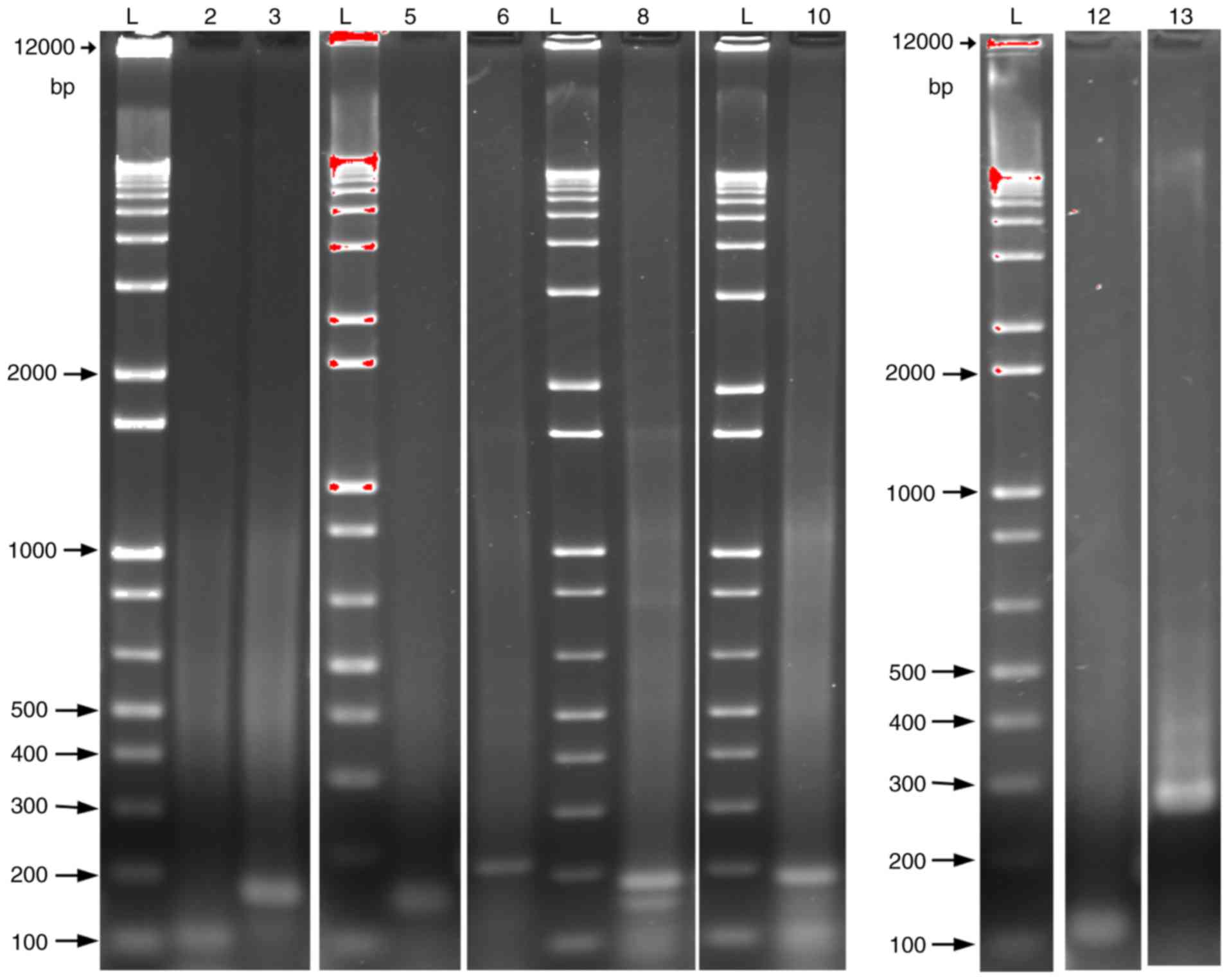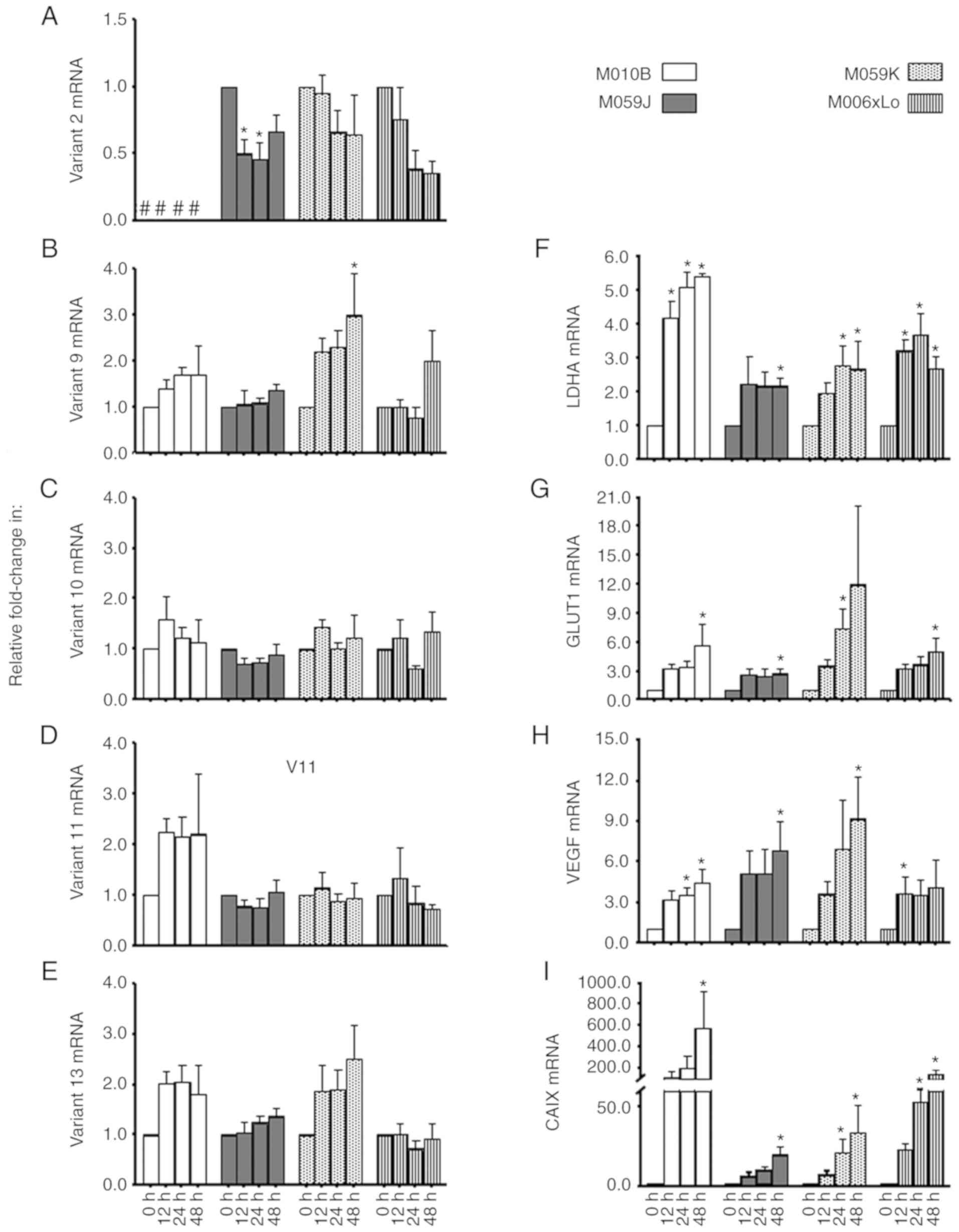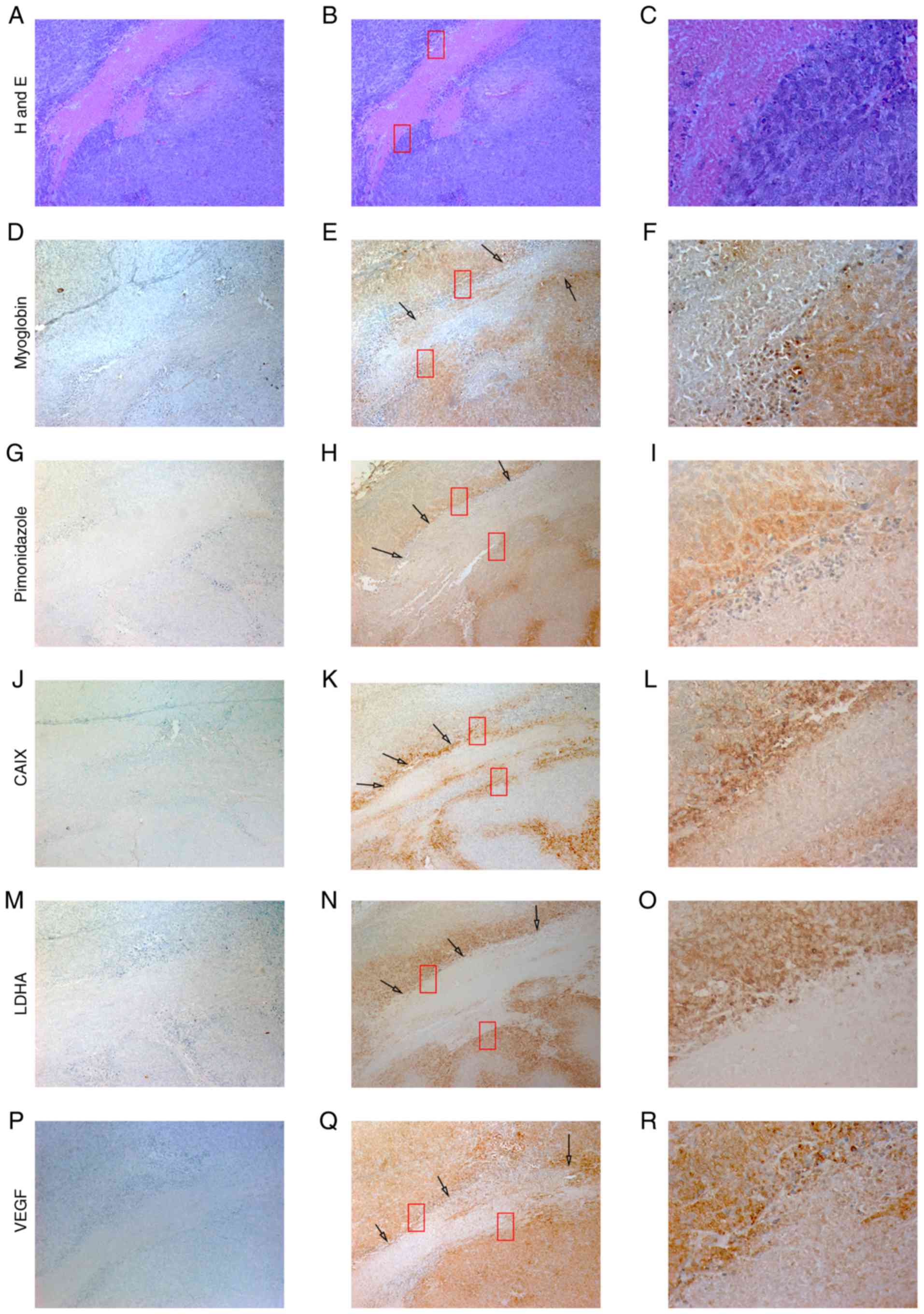|
1
|
Batash R, Asna N, Schaffer P, Francis N
and Schaffer M: Glioblastoma Multiforme, Diagnosis and Treatment;
Recent Literature Review. Curr Med Chem. 24:3002–3009. 2017.
View Article : Google Scholar : PubMed/NCBI
|
|
2
|
Pisapia DJ, Magge R and Ramakrishna R:
Improved pathologic diagnosis-forecasting the future in
glioblastoma. Front Neurol. 8:7072018. View Article : Google Scholar
|
|
3
|
Emara M, Turner AR and Allalunis-Turner J:
Hypoxic regulation of cytoglobin and neuroglobin expression in
human normal and tumor tissues. Cancer Cell Int. 10:332010.
View Article : Google Scholar : PubMed/NCBI
|
|
4
|
Harada H: How can we overcome tumor
hypoxia in radiation therapy? J Radiat Res. 52:545–556. 2011.
View Article : Google Scholar : PubMed/NCBI
|
|
5
|
Allalunis-Turner MJ, Franko AJ and
Parliament MB: Modulation of oxygen consumption rate and vascular
endothelial growth factor mRNA expression in human malignant glioma
cells by hypoxia. Br J Cancer. 80:104–109. 1999. View Article : Google Scholar : PubMed/NCBI
|
|
6
|
Franko AJ, Parliament MB, Allalunis-Turner
MJ and Wolokoff BG: Variable presence of hypoxia in M006 human
glioma spheroids and in spheroids and xenografts of clonally
derived sublines. Br J Cancer. 78:1261–1268. 1998. View Article : Google Scholar : PubMed/NCBI
|
|
7
|
Parliament MB, Franko AJ, Allalunis-Turner
MJ, Mielke BW, Santos CL, Wolokoff BG and Mercer JR: Anomalous
patterns of nitroimidazole binding adjacent to necrosis in human
glioma xenografts: Possible role of decreased oxygen consumption.
Br J Cancer. 75:311–318. 1997. View Article : Google Scholar : PubMed/NCBI
|
|
8
|
Emara M and Allalunis-Turner J: Effect of
hypoxia on angiogenesis related factors in glioblastoma cells.
Oncol Rep. 31:1947–1953. 2014. View Article : Google Scholar : PubMed/NCBI
|
|
9
|
Emara M, Salloum N and Allalunis-Turner J:
Expression and hypoxic up-regulation of neuroglobin in human
glioblastoma cells. Mol Oncol. 3:45–53. 2009. View Article : Google Scholar : PubMed/NCBI
|
|
10
|
Emara M, Turner AR and Allalunis-Turner J:
Adult, embryonic and fetal hemoglobin are expressed in human
glioblastoma cells. Int J Oncol. 44:514–520. 2014. View Article : Google Scholar : PubMed/NCBI
|
|
11
|
Emara M, Turner AR and Allalunis-Turner J:
Hypoxia differentially upregulates the expression of embryonic,
fetal and adult hemoglobin in human glioblastoma cells. Int J
Oncol. 44:950–958. 2014. View Article : Google Scholar : PubMed/NCBI
|
|
12
|
Kendrew JC, Dickerson RE, Strandberg BE,
Hart RG, DAVIES DR, Phillips DC and Shore VC: Structure of
myoglobin: A three-dimensional Fourier synthesis at 2 A.
resolution. Nature. 185:422–427. 1960. View Article : Google Scholar : PubMed/NCBI
|
|
13
|
Totzeck M, Hendgen-Cotta UB, Rammos C,
Petrescu AM, Meyer C, Balzer J, Kelm M and Rassaf T: Assessment of
the functional diversity of human myoglobin. Nitric Oxide.
26:211–216. 2012. View Article : Google Scholar : PubMed/NCBI
|
|
14
|
Xie LK and Yang SH: Brain globins in
physiology and pathology. Med Gas Res. 6:154–163. 2016. View Article : Google Scholar : PubMed/NCBI
|
|
15
|
Qiu Y, Sutton L and Riggs AF:
Identification of myoglobin in human smooth muscle. J Biol Chem.
273:23426–23432. 1998. View Article : Google Scholar : PubMed/NCBI
|
|
16
|
Fraser J, de Mello LV, Ward D, Rees HH,
Williams DR, Fang Y, Brass A, Gracey AY and Cossins AR:
Hypoxia-inducible myoglobin expression in nonmuscle tissues. Proc
Natl Acad Sci USA. 103:2977–2981. 2006. View Article : Google Scholar : PubMed/NCBI
|
|
17
|
Roesner A, Mitz SA, Hankeln T and
Burmester T: Globins and hypoxia adaptation in the goldfish,
Carassius auratus. FEBS J. 275:3633–3643. 2008. View Article : Google Scholar : PubMed/NCBI
|
|
18
|
Meller S, VAN Ellen A, Gevensleben H,
Bicker A, Hankeln T, Gorr TA, Sailer V, Dröge F, Schröck F, Bootz
F, et al: Ectopic myoglobin expression is associated with a
favourable outcome in head and neck squamous cell carcinoma
patients. Anticancer Res. 36:6235–6241. 2016. View Article : Google Scholar : PubMed/NCBI
|
|
19
|
Bicker A, Dietrich D, Gleixner E,
Kristiansen G, Gorr TA and Hankeln T: Extensive transcriptional
complexity during hypoxia-regulated expression of the myoglobin
gene in cancer. Hum Mol Genet. 23:479–490. 2014. View Article : Google Scholar : PubMed/NCBI
|
|
20
|
Meller S, Bicker A, Montani M, Ikenberg K,
Rostamzadeh B, Sailer V, Wild P, Dietrich D, Uhl B, Sulser T, et
al: Myoglobin expression in prostate cancer is correlated to
androgen receptor expression and markers of tumor hypoxia. Virchows
Arch. 465:419–427. 2014. View Article : Google Scholar : PubMed/NCBI
|
|
21
|
Bicker A, Brahmer AM, Meller S,
Kristiansen G, Gorr TA and Hankeln T: The distinct gene regulatory
network of myoglobin in prostate and breast cancer. PLoS One.
10:e01426622015. View Article : Google Scholar : PubMed/NCBI
|
|
22
|
Behnes CL, Bedke J, Schneider S, Küffer S,
Strauss A, Bremmer F, Ströbel P and Radzun HJ: Myoglobin expression
in renal cell carcinoma is regulated by hypoxia. Exp Mol Pathol.
95:307–312. 2013. View Article : Google Scholar : PubMed/NCBI
|
|
23
|
Oleksiewicz U, Daskoulidou N, Liloglou T,
Tasopoulou K, Bryan J, Gosney JR, Field JK and Xinarianos G:
Neuroglobin and myoglobin in non-small cell lung cancer:
Expression, regulation and prognosis. Lung Cancer. 74:411–418.
2011. View Article : Google Scholar : PubMed/NCBI
|
|
24
|
Ruck P, Horny HP, Greschniok A, Wehrmann M
and Kaiserling E: Nonspecific immunostaining of blast cells of
acute leukemia by antibodies against nonhemopoietic antigens.
Hematol Pathol. 9:49–56. 1995.PubMed/NCBI
|
|
25
|
Zhang PJ, Goldblum JR, Pawel BR, Fisher C,
Pasha TL and Barr FG: Immunophenotype of desmoplastic small round
cell tumors as detected in cases with EWS-WT1 gene fusion product.
Mod Patho. 16:229–235. 2003. View Article : Google Scholar
|
|
26
|
Flonta SE, Arena S, Pisacane A, Michieli P
and Bardelli A: Expression and functional regulation of myoglobin
in epithelial cancers. Am J Pathol. 175:201–206. 2009. View Article : Google Scholar : PubMed/NCBI
|
|
27
|
Kristiansen G, Rose M, Geisler C,
Fritzsche FR, Gerhardt J, Lüke C, Ladhoff AM, Knüchel R, Dietel M,
Moch H, et al: Endogenous myoglobin in human breast cancer is a
hallmark of luminal cancer phenotype. Br J Cancer. 102:1736–1745.
2010. View Article : Google Scholar : PubMed/NCBI
|
|
28
|
Allalunis-Turner MJ, Barron GM, Day RS
III, Fulton DS and Urtasun RC: Radiosensitivity testing of human
primary brain tumor specimens. Int J Radiat Oncol Biol Phys.
23:339–343. 1992. View Article : Google Scholar : PubMed/NCBI
|
|
29
|
Turcotte ML, Parliament M, Franko A and
Allalunis-Turner J: Variation in mitochondrial function in
hypoxia-sensitive and hypoxia-tolerant human glioma cells. Br J
Cancer. 86:619–624. 2002. View Article : Google Scholar : PubMed/NCBI
|
|
30
|
Catania A, Urban S, Yan E, Hao C, Barron G
and Allalunis-Turner J: Expression and localization of
cyclin-dependent kinase 5 in apoptotic human glioma cells. Neuro
Oncol. 3:89–98. 2001. View Article : Google Scholar : PubMed/NCBI
|
|
31
|
DeHaan C, Habibi-Nazhad B, Yan E, Salloum
N, Parliament M and Allalunis-Turner J: Mutation in mitochondrial
complex I ND6 subunit is associated with defective response to
hypoxia in human glioma cells. Mol Cancer. 3:192004. View Article : Google Scholar : PubMed/NCBI
|
|
32
|
Kristiansen G, Hu J, Wichmann D, Stiehl
DP, Rose M, Gerhardt J, Bohnert A, ten Haaf A, Moch H, Raleigh J,
et al: Endogenous myoglobin in breast cancer is hypoxia-inducible
by alternative transcription and functions to impair mitochondrial
activity: A role in tumor suppression? J Biol Chem.
286:43417–43428. 2011. View Article : Google Scholar : PubMed/NCBI
|
|
33
|
Altschul SF, Madden TL, Schaffer AA, Zhang
J, Zhang Z, Miller W and Lipman DJ: Gapped BLAST and PSI-BLAST: A
new generation of protein database search programs. Nucleic Acids
Res. 25:3389–3402. 1997. View Article : Google Scholar : PubMed/NCBI
|
|
34
|
Koch CJ, Howell RL and Biaglow JE:
Ascorbate anion potentiates cytotoxicity of nitro-aromatic
compounds under hypoxic and anoxic conditions. Br J Cancer.
39:321–329. 1979. View Article : Google Scholar : PubMed/NCBI
|
|
35
|
Livak KJ and Schmittgen TD: Analysis of
relative gene expression data using real-time quantitative PCR and
the 2(-Delta Delta C(T)) method. Methods. 25:402–408. 2001.
View Article : Google Scholar : PubMed/NCBI
|
|
36
|
Ghandi M, Huang FW, Jane-Valbuena J,
Kryukov GV, Lo CC, McDonald ER III, Barretina J, Gelfand ET,
Bielski CM, Li H, et al: Next-generation characterization of the
Cancer Cell Line Encyclopedia. Nature. 569:503–508. 2019.
View Article : Google Scholar : PubMed/NCBI
|
|
37
|
Kleiter MM, Thrall DE, Malarkey DE, Ji X,
Lee DY, Chou SC and Raleigh JA: A comparison of oral and
intravenous pimonidazole in canine tumors using intravenous
CCI-103F as a control hypoxia marker. Int J Radiat Oncol Biol Phys.
64:592–602. 2006. View Article : Google Scholar : PubMed/NCBI
|
|
38
|
Grillo F, Bruzzone M, Pigozzi S, Prosapio
S, Migliora P, Fiocca R and Mastracci L: Immunohistochemistry on
old archival paraffin blocks: Is there an expiry date? J Clin
Pathol. 70:988–993. 2017. View Article : Google Scholar : PubMed/NCBI
|
|
39
|
Murray D, Mirzayans R, Scott AL and
Allalunis-Turner MJ: Influence of oxygen on the radiosensitivity of
human glioma cell lines. Am J Clin Oncol. 26:e169–e177. 2003.
View Article : Google Scholar : PubMed/NCBI
|
|
40
|
Dengler VL, Galbraith M and Espinosa JM:
Transcriptional regulation by hypoxia inducible factors. Crit Rev
Biochem Mol Biol. 49:1–15. 2014. View Article : Google Scholar : PubMed/NCBI
|
|
41
|
Kaluz S, Kaluzova M, Liao SY, Lerman M and
Stanbridge EJ: Transcriptional control of the tumor- and
hypoxia-marker carbonic anhydrase 9: A one transcription factor
(HIF-1) show? Biochim Biophys Acta. 1795:162–172. 2009.PubMed/NCBI
|
|
42
|
Cui XG, Han ZT, He SH, Wu XD, Chen TR,
Shao CH, Chen DL, Su N, Chen YM, Wang T, et al: HIF1/2α mediates
hypoxia-induced LDHA expression in human pancreatic cancer cells.
Oncotarget. 8:24840–24852. 2017.PubMed/NCBI
|
|
43
|
Turner KJ, Crew JP, Wykoff CC, Watson PH,
Poulsom R, Pastorek J, Ratcliffe PJ, Cranston D and Harris AL: The
hypoxia-inducible genes VEGF and CA9 are differentially regulated
in superficial vs. invasive bladder cancer. Br J Cancer.
86:1276–1282. 2002. View Article : Google Scholar : PubMed/NCBI
|
|
44
|
Chiche J, Brahimi-Horn MC and Pouyssegur
J: Tumour hypoxia induces a metabolic shift causing acidosis: A
common feature in cancer. J Cell Mol Med. 14:771–794. 2010.
View Article : Google Scholar : PubMed/NCBI
|
|
45
|
Kanatous SB, Mammen PP, Rosenberg PB,
Martin CM, White MD, Dimaio JM, Huang G, Muallem S and Garry DJ:
Hypoxia reprograms calcium signaling and regulates myoglobin
expression. Am J Physiol Cell Physiol. 296:C393–C402. 2009.
View Article : Google Scholar : PubMed/NCBI
|
|
46
|
Wystub S, Ebner B, Fuchs C, Weich B,
Burmester T and Hankeln T: Interspecies comparison of neuroglobin,
cytoglobin and myoglobin: Sequence evolution and candidate
regulatory elements. Cytogenet Genome Res. 105:65–78. 2004.
View Article : Google Scholar : PubMed/NCBI
|
|
47
|
Tamaki N and Hirata K: Tumor hypoxia: A
new PET imaging biomarker in clinical oncology. Int J Clin Oncol.
21:619–625. 2016. View Article : Google Scholar : PubMed/NCBI
|
|
48
|
Hirakawa Y, Tanaka T and Nangaku M: Renal
Hypoxia in CKD; Pathophysiology and detecting methods. Front
Physiol. 8:992017. View Article : Google Scholar : PubMed/NCBI
|
|
49
|
Brown JM and Wilson WR: Exploiting tumour
hypoxia in cancer treatment. Nat Rev Cancer. 4:437–447. 2004.
View Article : Google Scholar : PubMed/NCBI
|
|
50
|
Ljungkvist AS, Bussink J, Kaanders JH and
van der Kogel AJ: Dynamics of tumor hypoxia measured with
bioreductive hypoxic cell markers. Radiat Res. 167:127–145. 2007.
View Article : Google Scholar : PubMed/NCBI
|
|
51
|
Huszthy PC, Daphu I, Niclou SP, Stieber D,
Nigro JM, Sakariassen PØ, Miletic H, Thorsen F and Bjerkvig R: In
vivo models of primary brain tumors: Pitfalls and perspectives.
Neuro Oncol. 14:979–993. 2012. View Article : Google Scholar : PubMed/NCBI
|
|
52
|
Patrizii M, Bartucci M, Pine SR and
Sabaawy HE: Utility of glioblastoma patient-derived orthotopic
xenografts in drug discovery and personalized therapy. Front Oncol.
8:232018. View Article : Google Scholar : PubMed/NCBI
|
|
53
|
Galluzzo M, Pennacchietti S, Rosano S,
Comoglio PM and Michieli P: Prevention of hypoxia by myoglobin
expression in human tumor cells promotes differentiation and
inhibits metastasis. J Clin Invest. 119:865–875. 2009. View Article : Google Scholar : PubMed/NCBI
|
|
54
|
Louis DN, Perry A, Reifenberger G, von
Deimling A, Figarella-Branger D, Cavenee WK, Ohgaki H, Wiestler OD,
Kleihues P and Ellison DW: The 2016 World Health Organization
Classification of Tumors of the Central Nervous System: A summary.
Acta Neuropathol. 131:803–820. 2016. View Article : Google Scholar : PubMed/NCBI
|
|
55
|
Huang J, Yu J, Tu L, Huang N, Li H and Luo
Y: Isocitrate dehydrogenase mutations in glioma: From basic
discovery to therapeutics development. Front Oncol. 9:5062019.
View Article : Google Scholar : PubMed/NCBI
|
|
56
|
Megova M, Drabek J, Koudelakova V,
Trojanec R, Kalita O and Hajduch M: Isocitrate dehydrogenase 1 and
2 mutations in gliomas. J Neurosci Res. 92:1611–1620. 2014.
View Article : Google Scholar : PubMed/NCBI
|
|
57
|
Liu Q, Guan JZ, Sun Y, Le Z, Zhang P, Yu D
and Liu Y: Insulin-like growth factor 1 receptor-mediated cell
survival in hypoxia depends on the promotion of autophagy via
suppression of the PI3K/Akt/mTOR signaling pathway. Mol Med Rep.
15:2136–2142. 2017. View Article : Google Scholar : PubMed/NCBI
|
|
58
|
Ezzeddini R, Taghikhani M, Somi MH, Samadi
N and Rasaee MJ: Clinical importance of FASN in relation to HIF-1α
and SREBP-1c in gastric adenocarcinoma. Life Sci. 224:169–176.
2019. View Article : Google Scholar : PubMed/NCBI
|
|
59
|
Koh YW, Lee SJ, Han JH, Haam S, Jung J and
Lee HW: PD-L1 protein expression in non-small-cell lung cancer and
its relationship with the hypoxia-related signaling pathways: A
study based on immunohistochemistry and RNA sequencing data. Lung
Cancer. 129:41–47. 2019. View Article : Google Scholar : PubMed/NCBI
|

















